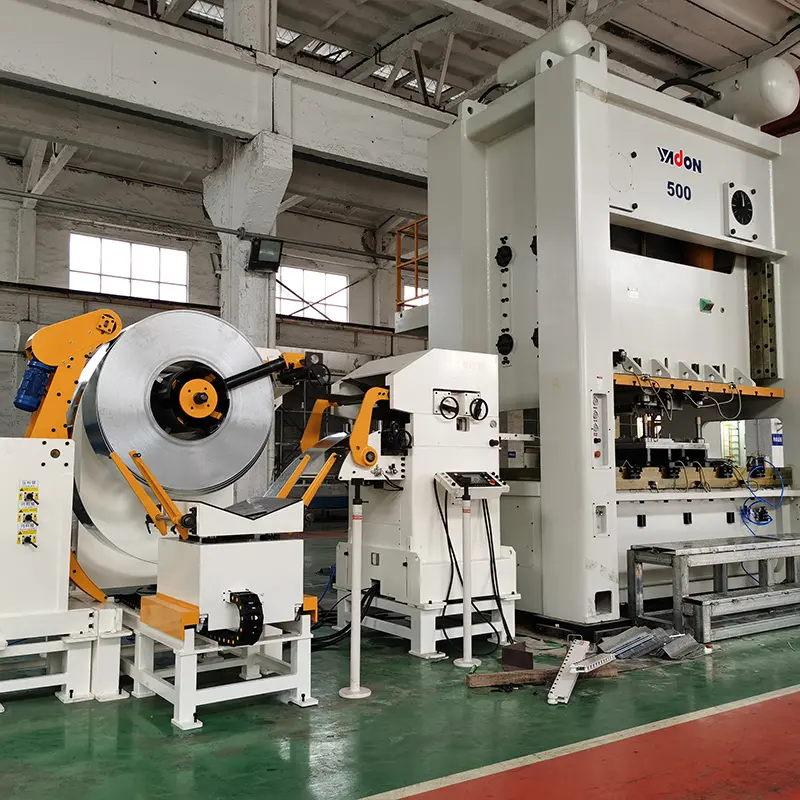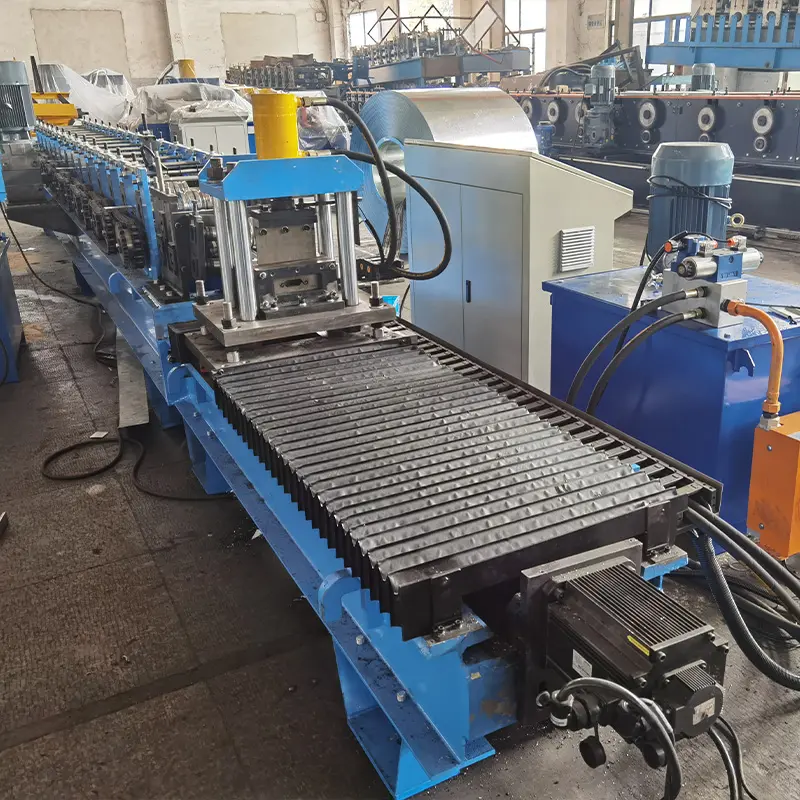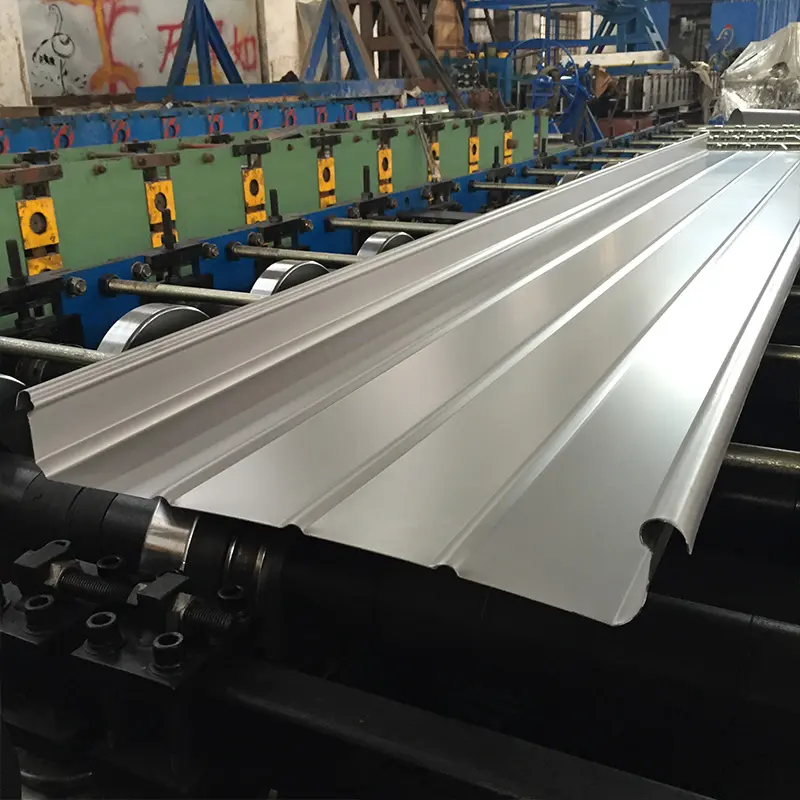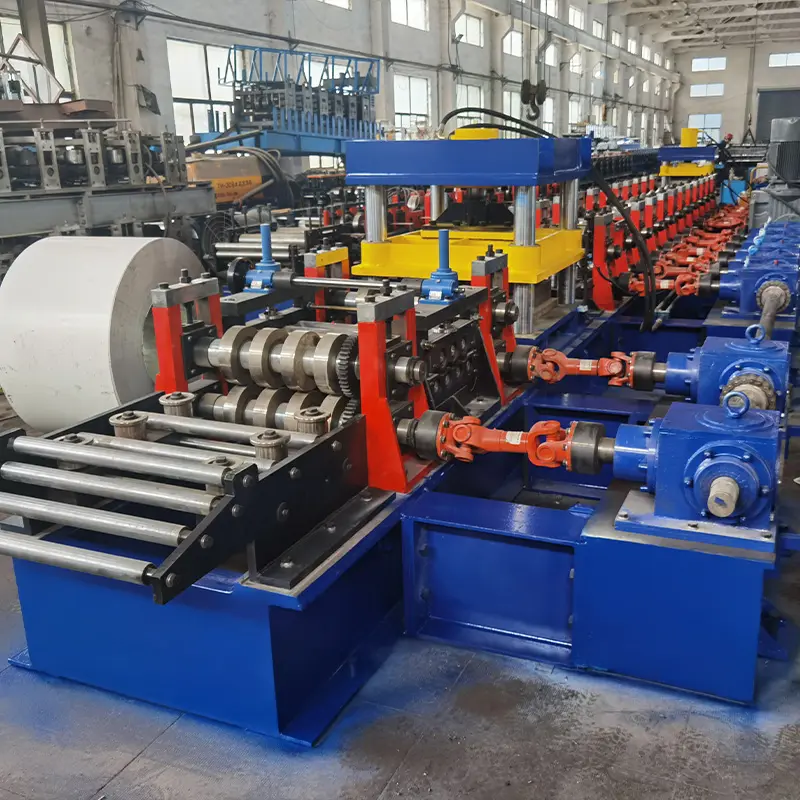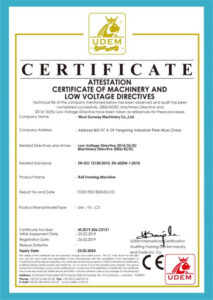Вальцовочные станки используют уникальную систему резки на длину для повышения эффективности производства рулонных профилей. Механизм летучих ножниц разрезает движущуюся полосу непосредственно перед тем, как она попадает в секцию формирования рулонов.
Основные сведения о валковых формовочных машинах с системой "летучий сдвиг":
- Система резки на длину, интегрированная в рулонный пресс
- Роторные ножницы режут движущуюся полосу с высокой скоростью
- Точная синхронизация работы ножниц со скоростью линии
- Обеспечивает более высокую общую скорость линии
- Быстрое и легкое изменение размера
- Используется для металлов толщиной до 4 мм
- Идеально подходит для изготовления деталей стандартной длины
- Обычно используется для изготовления кровельных панелей, настилов и панелей
Благодаря отсутствию необходимости останавливать и запускать типичные концевые ножницы, летучие ножницы оптимизируют процесс формовки валков.
Типы валковых профилегибочных машин
| Тип машины | Описание |
|---|---|
| Механическая | Регулировка времени сдвига с помощью женевского механизма и сервопривода |
| Электронный | Управление ножницами осуществляется с помощью ПЛК с обратной связью от энкодера |
| Гидравлический | Гидравлический цилиндр приводит в действие ножницы в нужный момент |
Механические летучие ножницы точное механическое время реза для более простой и экономичной конструкции.
Электронные летающие ножницы обеспечивают большую гибкость и регулировку скорости с помощью логического контроллера системы.
Гидравлические летучие ножницы Создают большое усилие срезания, сохраняя при этом точную синхронизацию.
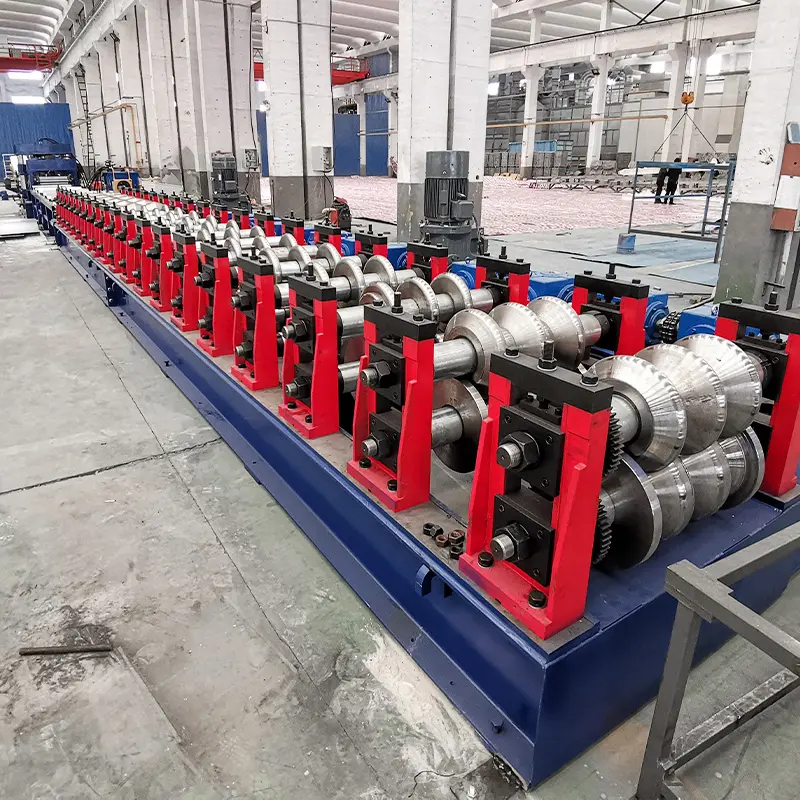
Основные компоненты валковых формовочных машин с летучими ножницами
| Компонент | Функция |
|---|---|
| Разматыватель | Подача ленты из рулона в линию с надлежащим натяжением |
| Валковая оснастка | Станции формовки постепенно придают полосе нужную форму |
| Летающий секатор | Роторные ножницы режут движущуюся полосу с высокой скоростью |
| Конвейер | Получает обрезанные детали и выгружает их с линии |
| Управление с помощью ПЛК | Координирует работу разматывателя, ножниц, конвейера и контроль |
| Интерфейс оператора | Сенсорный экран для управления и настройки параметров формования |
Летающие ножницы сочетают в себе технологию динамической формовки валков с синхронизированной высокоскоростной резкой, обеспечивая высочайшую производительность.
Типичные области применения роликовых формовочных линий с летающими ножницами
| Продукция | Подробности |
|---|---|
| Кровельные панели | Для панелей со скрытым креплением |
| Сайдинг и облицовка | Стеновые панели, архитектурные фасады |
| Настил | Настил крыши, напольные панели |
| Солнечные рамы | Для конструкций для монтажа солнечных батарей |
| Стеллажи | Регулируемые полки, опорные балки |
| Дренажные системы | Водосточные трубы, желоба, водостоки |
Рулонные станки с летучими ножницами идеально подходят для производства кровли, сайдинга, настила и многочисленных профилей стандартной длины.
Стандарты проектирования роликовых формовочных машин с подвижными ножницами
| Компонент | Стандарты |
|---|---|
| Рамка | Жесткая стальная сварная конструкция с ослабленным напряжением |
| Инструментальная оснастка | Закаленные валы, обработанные валы, подшипники |
| Лезвие ножниц | Закаленная сталь D2, термическая обработка |
| Время сдвига | Точное женевское или электронное управление |
| Приводы | Цилиндрические редукторы или серводвигатели |
| Средства управления | ПЛК, цветной сенсорный экран HMI |
| Отделка | Загрунтован, затем покрыт порошковой краской |
| Безопасность | Полностью закрытая защита, электронные стопоры |
Прочная рама в сочетании с высококачественными компонентами и интеллектуальными системами управления обеспечивает надежную, стабильную работу и качество конечного продукта.
Технические характеристики валковых формовочных машин с летучими ножницами
| Спецификация | Типовые значения |
|---|---|
| Скорость линии | 10 - 50 м/мин |
| Максимальная ширина полосы | 1000 - 1300 мм |
| Толщина Вместимость | 0,5 - 4 мм |
| Допуск длины | ± 1 мм |
| Диапазон длины | Любая длина отреза |
| Власть | 30 - 75 кВт |
| Вес машины | 5000 - 8000 кг |
Скорость, ширина и потребляемая мощность различаются для механических, гидравлических и электронных моделей летучих ножниц.
Подробная информация о ценах на оборудование для формовки рулонов с летучими ножницами
| Производитель | Диапазон цен |
|---|---|
| Metform | $150,000 – $250,000 |
| ЭТП | $140,000 – $220,000 |
| Samco | $160,000 – $280,000 |
| Китайские производители | $80,000 – $150,000 |
Цены варьируются от $80,000 до $280,000 в зависимости от размера, характеристик и точности. Установка и доставка добавляют 10-20%.
Монтаж и ввод в эксплуатацию станков с летучими ножницами
| Задача | Описание |
|---|---|
| Подготовка площадки | Освободите пространство, закрепите анкерные болты на фундаменте |
| Подъемник | Используйте соответствующие подъемные устройства для разгрузки секций |
| Сборка | Скрепите раму болтами; установите компоненты |
| Выравнивание | Точное выравнивание и уровень всех секций |
| Электрика | Проводка двигателей, ПЛК, элементов управления и принадлежностей |
| Конвейер | Болты в подающих и отводящих конвейерах |
| Тестовый запуск | Медленный цикл, проверка работы и резка деталей |
| Оптимизация | Уточнение времени сдвига, параметров управления |
Правильная установка и тщательное тестирование обеспечивают плавный запуск и качественную работу машины.
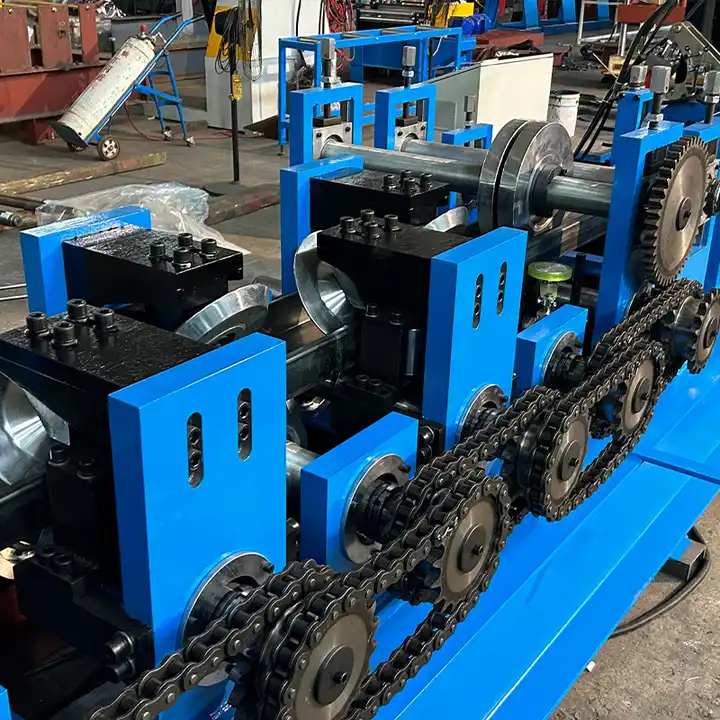
Эксплуатация и техническое обслуживание валковых линий с летающими ножницами
| Деятельность | Частота |
|---|---|
| Проверки безопасности | За смену |
| Загрузка катушки | По мере необходимости |
| Регулировка параметров | По мере необходимости |
| Смазка лезвий | Ежедневно |
| Проверка лезвий | Еженедельник |
| Смазка подшипников | Ежемесячно |
| Гидравлический сервис | Ежеквартально |
| Редукторное масло | В соответствии с инструкцией |
| Выравнивание | Ежегодно |
Необходимо ежедневно соблюдать правила техники безопасности. Бережная эксплуатация и регулярное техническое обслуживание являются залогом долговечности и производительности летучих ножниц.
Выбор производителя листогибочных машин
| Соображения | Руководство |
|---|---|
| Опыт | Обратите внимание на опыт работы с летающими ножницами |
| Настройка | Возможность адаптации машины к требованиям конкретного применения |
| Поддерживать | Помощь в установке, обучение, руководства, обслуживание |
| Репутация | Выбирайте проверенный бренд, известный своим качеством |
| Доставка | Производитель может выполнить поставку в соответствии с требуемым графиком |
| Значение | Соотношение возможностей и уплаченной цены |
Учитывайте опыт работы с этим специализированным оборудованием, а также настройку, поддержку и справедливую стоимость.
Преимущества рулонных формовочных линий с летающими ножницами
- Более быстрое производство по сравнению со стандартным вальцовочным станком с торцевыми ножницами
- Точная резка деталей непосредственно с рулонного пресса
- Быстрая и легкая смена размеров
- Увеличение производительности благодаря бесперебойному потоку ленты
- Идеально подходит для производства профилей стандартной длины
- Постоянный допуск и качество резки
- Компактная конструкция минимизирует пространство
- Снижение трудозатрат
- Возможность резки на лету
- Более простая обработка материалов
К основным преимуществам относятся скорость, простота переналадки, постоянство и экономия трудозатрат по сравнению с обычными системами остановки и резки.
Ограничения технологии формовки валков с летящими ножницами
- Более высокие первоначальные капитальные затраты по сравнению со стандартными валковыми формовочными машинами
- Требует более тщательного обслуживания и квалифицированной работы
- Ограничено тонким/мягким материалом
- Не так легко вырезать детали нестандартной длины
- Точное выравнивание необходимо для бесперебойной работы
- Механизмы синхронизации могут со временем изнашиваться
- Для различных профилей требуется специальная оснастка
- При изменении размеров может увеличиться время замены валов
- Образование брака при первоначальной настройке
Основные ограничения связаны с более высокой стоимостью и необходимостью технического обслуживания по сравнению с базовыми валковыми формовочными машинами.
Сравнение стоимости станков с летучими ножницами и торцевыми ножницами
| Тип машины | Диапазон цен | Преимущества | Недостатки |
|---|---|---|---|
| Летающий секатор | $150,000 – $300,000 | Более высокая скорость, легкое изменение длины | Более высокая стоимость, специализированное обслуживание |
| Торцевой сдвиг | $100,000 – $200,000 | Низкая первоначальная стоимость, простота эксплуатации | Метод медленной резки на длину |
Летающие ножницы повышают производительность, но имеют более высокие капитальные и эксплуатационные затраты. Оценивайте с учетом объема, переналадки и бюджета.
Устранение неисправностей, связанных с роликовыми линиями летающих ножниц
| Выпуск | Решение |
|---|---|
| Неточное определение времени сдвига | Отрегулируйте/замените изношенные шестерни; проверьте энкодер |
| Износ лезвия | Вращение/замена ножей ножниц |
| Следы от полос | Увеличение твердости лезвия/ролика; регулировка направляющих |
| Утечки в гидравлической системе | Замена уплотнений, шлангов, цилиндров |
| Избыточная вибрация | Проверьте выравнивание, крепления; при необходимости отремонтируйте. |
| Электрические неисправности | Проверьте/замените провода, соединения, приводы |
Правильное обслуживание ножей, а также оперативное устранение утечек, ослабления или проблем с электрикой предотвращают незапланированные простои.
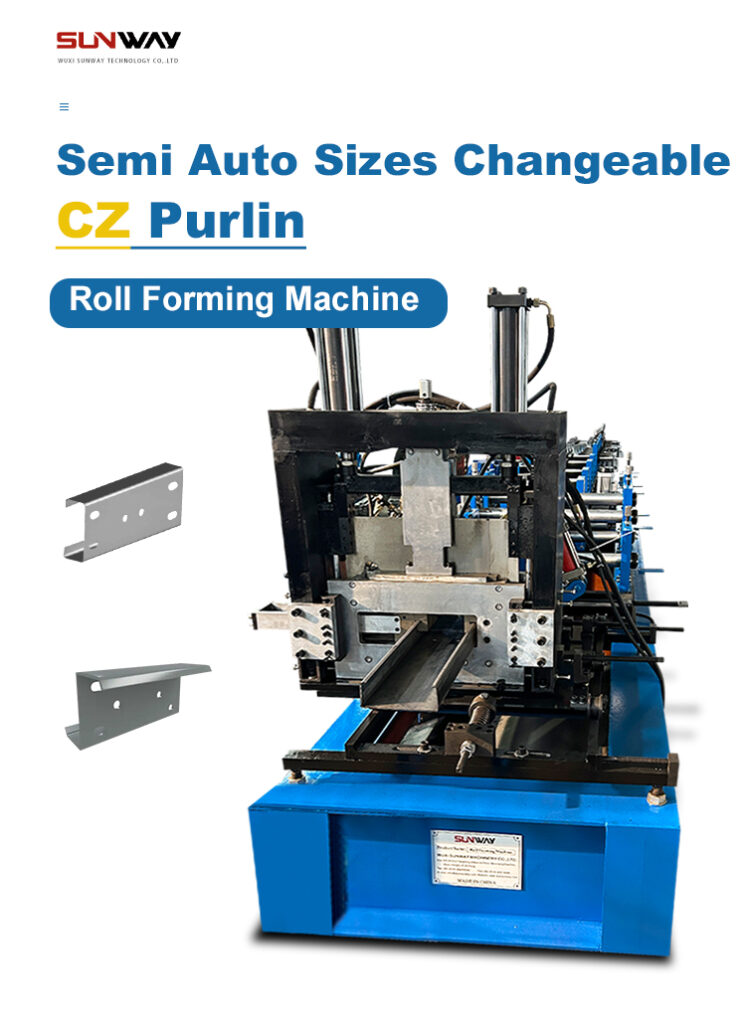
Часто задаваемые вопросы
В: Какую толщину стали могут выдерживать летающие ножницы?
О: Большинство станков могут работать с материалом толщиной до 4 мм. Для более толстого материала предлагаются более тяжелые модели.
В: С какой скоростью могут работать валковые опалубочные машины с летающими ножницами?
О: Скорость варьируется от 10 до более 50 метров в минуту в зависимости от размера машины.
В: Детали какой длины могут быть изготовлены?
О: Можно изготовить отрез любой длины, хотя типичная длина составляет от 1 до 7 метров.
В: Насколько точна длина отрезков?
О: Прецизионные летучие ножницы могут обеспечить допуск ± 1 мм или лучше.
В: Сколько времени занимает переход на новый профиль?
О: При использовании быстросменной оснастки смена профиля занимает в целом 30-60 минут.
В: Какие функции безопасности включены в комплект?
A: Полное ограждение, электронные стопоры, блокировки доступа и надежность управления в соответствии с действующими стандартами.
Вопрос: Каков типичный срок службы оборудования?
О: При надлежащем уходе можно ожидать примерно 15-20 лет продуктивного срока службы.
В: Какие виды гарантии предлагают производители?
О: Срок гарантии на большинство компонентов составляет от 6 месяцев до 1 года. Можно приобрести расширенную гарантию.

